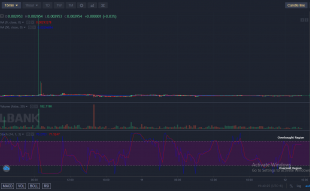Join Our Telegram channel to stay up to date on breaking news coverage
According to popular investment wisdom, if you don’t figure out how to make money while you sleep, you’ll work until you die. Nathan Worsley, a software engineer, has discovered a way to earn money not only while sleeping, but also while eating breakfast, going to the gym, and even relaxing in his London home’s sauna. He’s a crypto trading bot developer who has made millions over the last two years by training his predatory algorithms in a market where speculation is rampant and too-good-to-be-true returns have attracted hordes of gullible investors.
For example, last fall, the 33-year-old focused on decentralized finance (DeFi) platforms Wonderland and Abracadabra. They promised incredible returns of up to 80,000% to people who borrowed a coin called “Magic Internet Money” (MIM) and “staked,” or placed it in a sort of crypto savings account. Borrowers had to pledge collateral worth roughly 110% of the loan, but if the collateral’s value fell, the software or “smart contract” underlying the loan would automatically liquidate it.
Worsley and his trading bot found the most appealing aspect of the entire scheme to be a 12.5% reward paid to anyone willing to assist in the liquidation of borrowers whose collateral no longer met stipulated minimum requirements.
Unlike traditional finance, liquidations in crypto are automatic. When the value of your collateral falls below a certain threshold, it is seized and sold, and you are frequently left with only the funds you borrowed. It’s not like a margin call on a stock investment, where you might get a stern phone call from your broker demanding that you either shore up your collateral or pay back your loan.
On Abracadabra, collateral for a loan denominated in “Magic Internet Money” does not have to be in the form of cash or Treasury bills. A variety of speculative cryptos will suffice. As crypto prices began to fall in the fall of 2021, Worsley built a software bot to pounce in the event that MIM investors were suddenly forced to liquidate because some of the flimsy collateral tokens backing the loans swooned in value.
That’s exactly what happened in January 2022. Wonderland and Wmemo (a coin that stands for “Wonderful Memories”), two cryptocurrencies used as MIM collateral, dropped in value by 86% and 70%, respectively. Worsley’s bot got right to work. It had checked people’s balances and predicted who would be liquidated based on pending transactions and fluctuating crypto prices prior to the plunge. When it found a likely liquidation candidate, it sent a digital message to Abracadabra’s DeFi software informing it that it wanted to be the liquidator.
Worsley’s bot would quickly pay back the user’s original loan, receive an equivalent amount in collateral, and collect a bonus of up to 12.5% of the loan’s value if it was the first in line to do the job. Everything happened in a thousandth of a second, or about the time it takes for a camera to flash. Worsley received a $200,000 windfall as a result of over 1,000 liquidations.
Welcome to the bizarre world of MEV, or Maximal Extractable Value, in which software engineers-turned-traders try to outwit (and sometimes even sabotage) one another in order to profit from the unique and often inefficient structure of blockchain transactions. Consider Worsley’s small operation to be the crypto equivalent of high frequency trading hedge funds such as Citadel Securities and Virtu Financial in traditional stock markets.
“It’s a bit of an art form,” says Worsley, who ran a cryptocurrency exchange before becoming a MEV “searcher” two years ago. “I compare it to working as an engineer on a Formula One race car.” Every day, you tune this machine, trying to squeeze every ounce of performance out of it, and it’s racing against other people’s machines.”
Over the last two and a half years, experts estimate that at least $675 million in MEV profits have been realized on the Ethereum blockchain alone. When other blockchains such as Binance Smart Chain and Solana are included, the total MEV market profit easily exceeds $1 billion.
Not all MEV traders, like Worsley, are crypto repo men. Many people profit from changing the order of blockchain transactions. In the case of Ethereum, a transfer takes 12 seconds to complete. Bots can see every pending, unconfirmed transaction during that window, effectively peering into the future and allowing them to front-run trades.
“Ninety-nine percent of this stuff doesn’t look that different from traditional finance,” says Tarun Chitra, founder and CEO of Gauntlet, a crypto startup that helps decentralized finance projects assess risk.
Except that MEV traders operate in a largely unregulated environment. They don’t have to worry about guardrails like their stock market counterparts, and there’s no cop on the beat. Most MEV plays revolve around decentralized exchanges like Uniswap, which recently surpassed $1 trillion in total trading volume, rather than exchanges like Coinbase, which are subject to some regulatory oversight. And, just as high frequency traders, or “quants,” have emerged as the most profitable among Wall Street’s hedge funds, MEV crypto traders are raking in the dough.
“My MEV team is making more money in a day [than] your venture fund has ever made,” says Dean Eigenmann, a 24-year-old Swiss MEV searcher known for flaunting his leopard-print fur coat, $50,000 Patek Philippe watch, and nearly 40 tattoos on social media.
Sandwich assault
MEV strategies are classified into three types. The sandwich attack, a particularly pernicious form of front-running, is the most contentious. In this maneuver, a MEV bot detects someone else’s intent to buy a coin and positions itself to profit from the minor price increase caused by the other person’s bid. The bot skips the line to buy the coin for a fraction less, effectively leading the trade. The bot then completes the sandwich by automatically selling the token at a profit after the purchase by the mark in the middle is completed.
Front-running is profitable not only for MEV traders, but also for “validators” who use software to approve blockchain transactions. Just as big quant hedge funds pay brokers like Robinhood “payment for order flow” to buy the right to execute retail traders’ orders, front-running MEV traders essentially buy their way to the front of the line. As a result, the validators end up with a larger share of the front-running profits than the people who create the bots.
Arbitrage
Arbitrage is another common but less controversial MEV strategy in which traders take advantage of minute price differences for the same token on different exchanges. Given that there are over 500 loosely regulated crypto exchanges worldwide and thousands of cryptocurrencies, there is plenty of opportunity to profit. “Many people believe that this type of MEV is beneficial—it pushes the market to what the true price should be,” says Vy Le, a partner at Bain Capital Crypto and former SEC employee.
Liquidation play
The liquidation play, which Worsley’s bots profited from in January, is the final flavor of MEV trading. Liquidation trades are limited to DeFi platforms with high leverage.
MEV traders, understandably, are a low-key and secretive bunch. Symbolic Capital Partners (SCP), one of the most successful MEV trading firms, was cofounded by Lev Livnev, a 26-year-old programmer with a bushy head of red hair. SCP, on the other hand, has only a one-page website with a trippy logo, and multiple emails to the firm went unanswered.
This game involves a lot of money. According to sources, FTX billionaire Sam Bankman-Alameda Fried’s Research, one of the top crypto trading firms, is implementing MEV strategies on blockchains such as Solana. (Alameda Research declined to be interviewed or respond to email inquiries for this article.) Wintermute, a London-based firm that trades approximately $100 billion in digital assets per month, has an active MEV operation.
Dean Eigenmann leads his three-person MEV team as part of Dialectic, a Swiss investment firm he co-founded with Ryan Zurrer, a former partner at Polychain. Zurrer and Eigenmann will not discuss their individual MEV earnings, but Zurrer does provide some context. He estimates that up to 50 teams are actively competing in MEV, with about ten of them reaping the majority of the profits. He claims that the top-performing teams now bring in “high five figures, mid six figures” in profits per month and have netted millions in individual months when market conditions were ideal, particularly in mid-2021 and earlier. He adds that competition, as well as the overall crypto winter, has reduced profits since then.
The competition is frequently ruthless. Worsley claims that when he was on an 11-hour flight, members of a rival MEV firm launched a denial-of-service attack against his operation. His trading servers went down for hours, causing him to lose at least $100,000. “At the end of the day, you may be friends with people, but you’re all trying to bankrupt each other,” he says.
Worsley has stated that he will not engage in sandwich attacks and was enraged in early 2021 when he discovered that Ethermine, an Austrian company that accounted for 20% of all Ethereum mining at the time, according to CryptoCompare, was running sandwiches on traders. It’s as if the New York Stock Exchange were racing ahead of the investors whose trades it was processing.
“This is an organization that is mining blocks, so they are securing the blockchain itself,” Worsley explains. “I thought it was an affront to Ethereum users.”
Worsley created his own decoy cryptocurrency and built a trap into its code in response to Ethermine’s sandwich trades: You could purchase the token from someone else, but you couldn’t sell it. “It’s the worst possible thing you could have in a sandwich,” he says of the coin’s name, Salmonella. Then he enticed Ethermine with a transaction he expected their MEV bot to devour. In March 2021, Ethermine purchased the poison tokens and was stuck with them. Worsley claims he pocketed approximately $150,000 at Ethermine’s expense. Multiple requests for comment from Ethermine went unanswered.
“Not bad for a day’s work,” Worsley says.
It is up to the crypto community to devise a solution to the MEV scourge that encourages this dubious practice. Flashbots, a 2020 startup, develops software that makes MEV tools available to retail investors, with the goal of leveling the playing field, reducing MEV profits, and preventing power concentration.
Phil Daian, the cofounder of Flashbots, is a 28-year-old cryptocurrency researcher who co-authored a paper in 2019 describing how bots were preying on inexperienced cryptocurrency traders on Ethereum. The paper, titled “Flash Boys 2.0: Front-running, Transaction Reordering, and Consensus Instability in Decentralized Exchanges,” begins with a direct rebuttal to crypto idealists: “Blockchains, and particularly smart contracts, have promised to create fair and transparent trading ecosystems.” Unfortunately, we can see that this promise was not kept.”
You can bundle trading orders and specify that you only want to make a trade if you can successfully front-run another user using Flashbots’ software (it does this by letting traders pay validators a fee to jump to the front of the line). Using Flashbots will also keep you from being front-run. If Daian and others have their way, MEV trading will eventually become as simple for the novice investor as it is for large corporations.
Skip Protocol raised $6.5 million in seed funding from Bain Capital Crypto in September to do for the Cosmos blockchain what Flashbots did for Ethereum—make MEV more accessible and reduce bot transaction congestion. Other services, such as BloXroute, Jito Labs, and Rook, are also attempting to mitigate MEV in various ways, including returning some MEV profits to users. Meanwhile, DeFi platform Uniswap has added warnings when a user is about to place a trade that could be front-run.
For the time being, experts predict that the MEV market will continue to expand alongside the widespread adoption of decentralized exchanges.
Where have the regulators gone?
According to Cornell business school professor Maureen O’Hara, MEV front-running (or even a sandwich play) isn’t illegal in the same way that stock market front-running is because the information on pending orders used by MEV traders isn’t confidential—publicly it’s available on the blockchain.
It is possible to charge people with market manipulation and fraud. “They can always do that,” O’Hara says, pointing out that the wire fraud statute is extremely broad. For example, in September, the brother of a former Coinbase product manager pleaded guilty to one count of conspiracy to commit wire fraud as part of a scheme to commit “insider trading” by misusing confidential Coinbase information about which crypto assets were scheduled to be listed on its exchange, according to the government. The prosecutors’ insider trading hook was that Coinbase kept such information strictly private and forbade its employees from trading on it or informing others about it. It’s difficult to see how the same logic could be applied to publicly available blockchain data used by an unrelated individual.
For the time being, consider MEV’s robot traders to be yet another reason why most investors should avoid crypto. “No market succeeds if it is not perceived as fair,” says O’Hara. “That’s all there is to it.”
Related
- Ethereum’s Vitalik Buterin suggested a way to mitigate ETH censorship
- AI Trading For Beginners – Best AI Trading Bots
- Best Bitcoin Robots of 2022 – Automated Bitcoin Trading
Join Our Telegram channel to stay up to date on breaking news coverage


